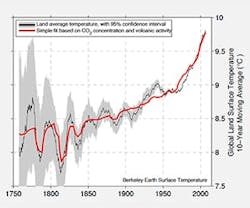An Update on GHG Emissions Reporting and Carbon Offsets
Why should you care about emissions reporting? Because based on your facility type, you may be required to report to the EPA, your state agency, or even to the Securities and Exchange Commission. More importantly, your customers and supply chain or distribution channels may expect your organization to be green in the same way they expect you to have a diversity or no sweatshop policy.
Due to recent climate-related events such as Superstorm Sandy, widespread droughts, and floods, U.S. consumers have become more sensitive to climate change. Even oil companies are now agreeing that climate change is real and largely a man-made phenomenon. If you haven’t followed the sudden change of opinions, you may consider research done by Dr. Richard Muller, who recently completed an exhaustive scientific review on whether climate change is man-made or not.
Regardless of your personal beliefs, the citizen/consumer (more than the government) is the key accelerator in the development of GHG reporting and offset trading in the carbon markets. This article will provide a brief update with new information from an international conference I just attended. It is relevant because buildings contribute more GHGs than any other sector. If you would like to review a little more background on the “Why, What, and How” of emissions reporting, click here for a short but comprehensive review.
Recent Developments
For the past few years, the U.S. GHG emissions market has been a little stagnant due to government policy inaction as well as dull economic conditions. Although there have been numerous international Conference of Parties (COP) meetings, the lack of a significant, binding successor agreement to the Kyoto Protocol has also caused a stalling of policy development. Despite these facts, the trading of voluntary carbon offsets and Renewable Energy Credits has remained active due to market, consumer, and local forces.
Some states, cities, and other authorities may have local regulations to reduce GHG emissions. Remember if a mayor or governor is elected on their environmental policy, they can implement local legislation that impacts you. Some politicians have become more aware of the impacts of climate change because the U.S. has been spending more on the affects from abnormal weather – for example, $60 billion was spent on damages from Superstorm Sandy.PageBreak
How These Trends Affect Buildings
If you have a large organization, it is likely that you will be expected to at least report your GHG emissions in order to satisfy a supplier, client, or regulatory need. For example, Wal-Mart started making their key suppliers complete a questionnaire from the Carbon Disclosure Project a few years ago, which had trickle-down reporting effects to thousands of companies. Occasionally, clients call me just to help them understand the questions and fill in the form!
If you require assistance to understand the GHG reporting landscape, terminology, or process, there are several courses/books and free resources and guides available. Some courses are internationally recognized, such as the CRM course, but you might not need all that training if you have a very small organization.
Regardless of your organization’s size, it is highly likely that even after you install energy efficient or renewable energy, you may still have a carbon footprint, though hopefully smaller. If you choose to, you can offset the remaining footprint by purchasing offset credits. Many organizations such as Starbucks, Whole Foods, and Pepsi do this voluntarily to improve their sustainability image or at least offset a portion of their carbon footprint.
There are a variety of offsets available and their creditworthiness is generally related to their cost. A compliance credit is a relatively rigorous one that an organization can use to meet a formal requirement. For example, if a utility uses more coal than they had forecasted, they could purchase a compliance offset credit (probably involving a forestry-related offset project) to close the gap.PageBreak
With states taking a more active role, you may also have state accredited offsets (such as the California Air Resource Board’s ARB Accredited Offsets). California is also entering an international agreement to trade emissions offsets with Quebec. To add to the complexity, you have primary and secondary markets, where offsets can be traded back and forth (like futures contracts). Sometimes to boost credibility and assure that the projects are actually reducing emissions, they can be double verified or pass other tests, which results in higher costs.
Because of all these variables, the main rule of thumb is to buy offsets from a reputable organization that is following an offset protocol or standard. This ensures they are developing their offset projects along strict guidelines that are verifiable and accepted as standard practices. For example, click here to see that the Climate Action Reserve has protocols (rule books) for different types of projects (this is similar to how IPMVP has guidelines for different energy projects). You can also detect who the reputable players are by their client list and who is putting trust in the idea that their carbon offsets are bullet-proof to scrutiny.
There are many other site-specific factors to consider to optimize your offset purchases. For example, in some areas, you can only offset up to 8% of your footprint. If this topic is important to you, learn what rules are going to apply to your location or facility type.
